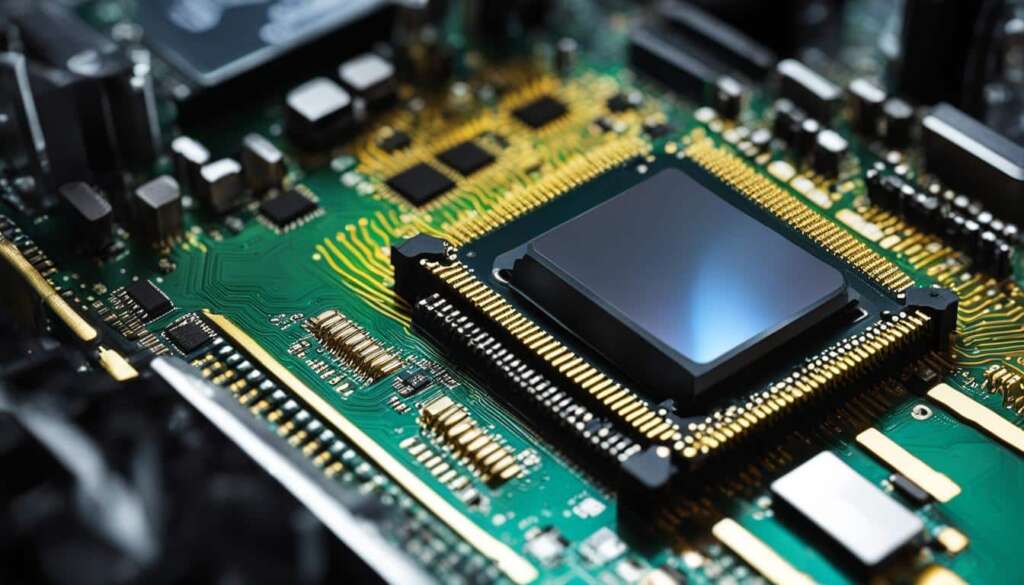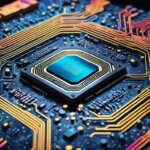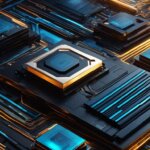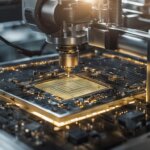Table of Contents
Dynamic random access memory (DRAM) is a widely used type of semiconductor memory in personal computers (PCs), workstations, and servers. As a type of random access memory (RAM), DRAM allows the processor to directly access any part of the memory. It works by storing data in storage cells organized in a two-dimensional grid. These cells need to be refreshed periodically to compensate for charge leaks.
There are different types of DRAM, such as synchronous DRAM (SDRAM), Rambus DRAM (RDRAM), Double Data Rate SDRAM (DDR SDRAM), Fast Page Mode DRAM (FPM DRAM), and Extended Data Out DRAM (EDO DRAM). Each type has its own advantages and applications. While DRAM offers advantages such as simplicity, low cost, and high density, it also has disadvantages such as volatility and high power consumption compared to other types of memory.
How Does DRAM Work?
DRAM (Dynamic Random Access Memory) is a type of semiconductor memory that utilizes storage cells comprising capacitors and transistors to store data. These storage cells are organized in a grid-like structure.
When a charge is transmitted through a specific column, the corresponding transistor activates, enabling access to the stored data. Each cell represents a bit of information, either 0 or 1.
However, it’s important to note that DRAM storage cells are dynamic in nature. Due to the nature of capacitors, they experience charge leaks. To counteract this, the cells need to be regularly refreshed every few milliseconds. This process involves recharging the capacitors to compensate for the charge loss.
DRAM memory cells work in conjunction with other circuits that help identify rows and columns, keep track of the refresh process, and instruct the cells to accept or release charges. These circuits also ensure the smooth reading or restoration of data from a cell.
“DRAM works by storing data in storage cells consisting of capacitors and transistors. The cells need to be refreshed periodically to compensate for charge leaks.”
Advantages of DRAM:
- Simple design with low cost
- High-density storage capacity
- Allows for data refresh and deletion while a program is running
Disadvantages of DRAM:
- Volatility: Data is lost when power is removed
- High power consumption compared to other memory options
- Complex manufacturing process
- Slower compared to static RAM (SRAM)
Comparison with SRAM:
DRAM is a successor to SRAM and offers advantages such as lower production costs and higher density. However, SRAM retains certain advantages over DRAM, including faster read and write speeds due to its different operational principles. SRAM is commonly used for cache memory. In terms of power consumption, DRAM requires less power in an active state, while SRAM consumes less power in sleep mode. Manufacturing processes for both are complex, but DRAM achieves higher density levels.
| DRAM | SRAM |
|---|---|
| Lower production costs | Faster read and write speeds |
| Higher density levels | Less power consumption in sleep mode |
Types of DRAM
Dynamic random access memory (DRAM) comes in various types that cater to different device requirements. Each type offers unique advantages and is designed for specific applications. Some of the main types of DRAM include:
Synchronous DRAM (SDRAM)
SDRAM, also known as SDR SDRAM, synchronizes the speed of memory with the CPU clock speed. This synchronization allows for faster data transfer and improved system performance. SDRAM is commonly used in personal computers, workstations, and servers.
Rambus DRAM (RDRAM)
RDRAM, developed by Rambus Inc., gained popularity in the early 2000s, particularly for graphics cards. It offered high bandwidth and was capable of delivering exceptional performance for multimedia applications.
Double Data Rate SDRAM (DDR SDRAM)
DDR SDRAM, often referred to simply as DDR, revolutionized the memory industry by doubling the data rate compared to SDRAM. This increase in data transfer speed was achieved by using both the rising and falling edges of the clock cycle, effectively doubling the bandwidth. DDR SDRAM is commonly used in desktops, laptops, and high-performance computing systems.
Fast Page Mode DRAM (FPM DRAM)
FPM DRAM, also known as Fast Page DRAM, focuses on optimizing page access for faster performance. It allows for consecutive memory accesses within a page without the need for repetitive row addressing, resulting in improved data transfer speeds.
Extended Data Out DRAM (EDO DRAM)
EDO DRAM enhances read performance on microprocessors by allowing for faster access to subsequent data within a burst operation. It provides a slight performance improvement over FPM DRAM by reducing the delays associated with accessing data within a page.
These are some of the main types of DRAM used in the industry, each offering its own advantages and applications. The choice of DRAM type depends on factors such as system requirements, desired performance, and cost considerations.
| DRAM Type | Advantages | Applications |
|---|---|---|
| Synchronous DRAM (SDRAM) | – Synchronizes memory speed with CPU clock speed – Faster data transfer – Improved system performance |
– Personal computers – Workstations – Servers |
| Rambus DRAM (RDRAM) | – High bandwidth – Excellent performance for multimedia applications |
– Graphics cards |
| Double Data Rate SDRAM (DDR SDRAM) | – Doubles data transfer rate – Increased bandwidth |
– Desktops – Laptops – High-performance computing systems |
| Fast Page Mode DRAM (FPM DRAM) | – Optimized page access – Faster data transfer within a page |
– Various computing systems |
| Extended Data Out DRAM (EDO DRAM) | – Improved read performance on microprocessors – Faster access to subsequent data within a burst operation |
– Computing systems requiring faster read times |
Please note that the table above serves as a summary and does not capture all possible advantages and applications of each DRAM type. The selection of DRAM should be based on specific requirements and consultation with trusted experts in the field.
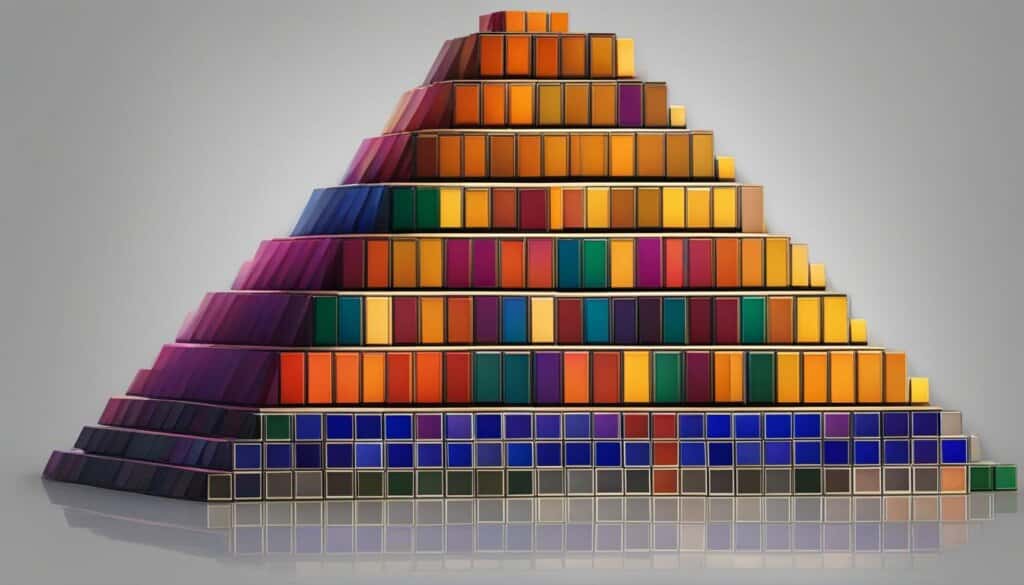
DRAM Packages
DRAM comes in different packaging options to accommodate various devices and systems. Let’s explore the different types of DRAM packages available in the market today.
One of the earlier packaging options was the single inline memory module (SIMM). SIMMs were widely used in the past but are now considered obsolete. They were equipped with either 30 or 72 pin connectors, allowing for easy installation and removal.
Today, the more commonly used packaging option for DRAM is the dual inline memory module (DIMM). DIMMs have pins on both sides of the chip, providing a stable and secure connection. They typically come with 168 pin connectors or more, depending on the specific requirements of the system.
Let’s have a closer look at the different types of DIMMs:
- Unbuffered DIMMs (UDIMMs): UDIMMs are designed for desktops and laptops. They are cost-effective and provide reliable performance for everyday computing tasks.
- Registered DIMMs (RDIMMs): RDIMMs are commonly used in servers, where stability and performance are essential. They include an additional register to minimize system loading and improve memory reliability.
- Fully Buffered DIMMs (FB-DIMMs): FB-DIMMs are utilized in larger memory systems. They feature an advanced buffering technology that allows for high-capacity memory configurations with increased bandwidth.
Each type of DIMM has its own advantages in terms of cost, stability, and performance. Below, you can find a table summarizing the key features of these DRAM package types:
| DRAM Package Type | Usage | Advantages |
|---|---|---|
| Unbuffered DIMMs (UDIMMs) | Desktops and laptops | Cost-effective and reliable performance |
| Registered DIMMs (RDIMMs) | Servers | Improved stability and performance |
| Fully Buffered DIMMs (FB-DIMMs) | Larger memory systems | High-capacity configurations with increased bandwidth |
As technology continues to advance, new packaging options may emerge to meet the evolving demands of memory systems. However, the SIMM and DIMM packaging options remain the most widely used and continue to play a crucial role in the world of DRAM.
Advantages of DRAM
DRAM, or dynamic random access memory, offers several advantages that make it a popular choice for memory storage in various electronic devices. The simplicity of its design, combined with its low cost and high density, are key factors that contribute to its widespread use. Furthermore, DRAM allows for data refresh and deletion while a program is running, providing flexibility and convenience to users.
The design of DRAM is characterized by the presence of only one transistor in each memory cell. This simple design reduces manufacturing complexity and cost, making DRAM an affordable option compared to alternative memory types. With its straightforward structure, DRAM is relatively easy to produce, resulting in cost-effective memory solutions for different applications.
Another advantage of DRAM is its high density capability. DRAM allows for the storage of a large amount of data in a small physical space, making it an ideal choice for devices with limited memory capacity. The high density of DRAM enables more efficient data storage, which is particularly beneficial for memory-intensive tasks.
Additionally, DRAM permits data refresh while the system is operational. This means that the memory cells can be periodically refreshed to compensate for charge leaks and prevent data loss. The ability to refresh data on the go ensures the reliability and stability of stored information.
“DRAM’s simple design, low cost, high density, and data refresh capability make it a versatile memory storage solution for various electronic devices.”
Overall, DRAM’s advantages, such as its simple design, low cost, high density, and data refresh capability, make it a widely used memory storage solution. Its cost-effectiveness, combined with its ability to store large amounts of data and provide flexibility in data management, makes DRAM an attractive option for diverse applications.
Disadvantages of DRAM
Despite its numerous advantages, DRAM also comes with several disadvantages that need to be considered. These disadvantages include the volatile nature of DRAM, high power consumption, complex manufacturing process, and slower performance compared to SRAM.
Volatile Memory
One of the main disadvantages of DRAM is its volatility. As a volatile memory, DRAM loses all stored data when power is removed. This means that any unsaved information or work in progress will be lost, making it essential to save data frequently to prevent data loss.
High Power Consumption
Compared to other memory options, DRAM consumes a significant amount of power. The constant refreshing of memory cells, combined with the need to maintain data integrity, leads to higher power consumption. This can result in increased energy costs and may require additional cooling measures to prevent overheating.
Complex Manufacturing
The manufacturing process of DRAM is complex compared to alternative memory types. The intricate design and structure of DRAM cells require precise manufacturing techniques, making the production process more intricate and time-consuming. This complexity contributes to the higher overall cost of DRAM compared to other memory options.
Slower Performance
Another disadvantage of DRAM is its slower performance compared to static RAM (SRAM), a type of memory commonly used for cache memory. The dynamic nature of DRAM, which requires periodic refreshing, results in slower read and write speeds compared to SRAM. While DRAM excels in storage density, its slower performance can impact overall system speed and responsiveness.
DRAM vs. SRAM
DRAM, as the successor to SRAM, offers certain advantages over its predecessor. One significant advantage is its lower production cost compared to SRAM. DRAM achieves this through having fewer elements per bit and eliminating differential bit lines.
However, SRAM retains its own set of advantages over DRAM. Unlike DRAM, SRAM does not require periodic refreshing due to operating on different principles. As a result, SRAM is commonly used for cache memory, enabling faster reads and writes compared to DRAM.
The power consumption of both DRAM and SRAM varies depending on the system’s state. In the active mode, DRAM requires less power than SRAM. Conversely, SRAM consumes less power in sleep mode. These differences in power consumption stem from the distinct operational characteristics of DRAM and SRAM.
Manufacturing processes for both types of memory are complex. However, DRAM holds an advantage in terms of higher density levels, allowing for greater storage capacity.
| DRAM | SRAM |
|---|---|
| Lower production cost | No need for refreshing |
| Slower reads/writes compared to SRAM | Faster reads/writes |
| Requires less power in active mode | Consumes less power in sleep mode |
| Complex manufacturing process | Complex manufacturing process |
| Higher density levels | Lower density levels |
History of DRAM
The history of DRAM can be traced back to the mid-1960s when it was first used in a Toshiba calculator. However, during that time, it faced tough competition from magnetic-core memory. The development of DRAM technology took a significant leap forward with the invention of the metal-oxide-semiconductor field-effect transistor (MOSFET) and the metal-oxide-semiconductor DRAM (MOS DRAM) in the late 1960s. These advancements paved the way for Intel to further enhance DRAM technology with the introduction of the Intel 1103 in 1970, marking its commercial viability.
Over the years, significant progress has been made in DRAM capacity, doubling every two years as a result of technological improvements. However, latency, or the time delay in accessing data, has not seen substantial improvements. Another challenge for DRAM systems is power consumption, as a large portion of data center power is attributed to DRAM usage.
As technology continues to advance, there is a possibility that DRAM may eventually be replaced by alternative memory technologies like phase change memory and STT-RAM. Additionally, interconnects could be adapted to use photonic solutions to overcome the bandwidth limitations caused by traditional pins on chips.
FAQ
What is DRAM?
DRAM stands for dynamic random access memory and is a type of semiconductor memory commonly used in PCs, workstations, and servers. It is a type of RAM that allows the CPU to directly access any part of the memory.
How does DRAM work?
DRAM works by storing data in storage cells consisting of capacitors and transistors. When a charge is sent through a column, the transistor at the column is activated, allowing the data to be accessed. The DRAM cells need to be refreshed periodically to compensate for charge leaks.
What are the types of DRAM?
There are several types of DRAM, including synchronous DRAM (SDRAM), Rambus DRAM (RDRAM), Double Data Rate SDRAM (DDR SDRAM), Fast Page Mode DRAM (FPM DRAM), and Extended Data Out DRAM (EDO DRAM).
What are the types of DRAM packages?
DRAM packages include single inline memory module (SIMM) and dual inline memory module (DIMM). DIMMs are more commonly used now and come in various types such as unbuffered DIMMs (UDIMMs), registered DIMMs (RDIMMs), and fully buffered DIMMs (FB-DIMMs).
What are the advantages of DRAM?
DRAM has a simple design, low cost, and high density, allowing for more data storage. It also allows for memory refreshing and data deletion while a program is running, providing flexibility.
What are the disadvantages of DRAM?
DRAM is volatile, meaning data stored in it is lost when power is removed. It also has higher power consumption compared to other memory options, complex manufacturing processes, and is slower than SRAM.
How does DRAM compare to SRAM?
SRAM does not require refreshing and is generally used for cache memory, enabling faster reads and writes compared to DRAM. DRAM, on the other hand, has higher density levels and is less expensive to produce.
What is the history of DRAM?
The history of DRAM dates back to the mid-1960s when it was first used in a Toshiba calculator. DRAM technology improved over the years with inventions such as the metal-oxide-semiconductor field-effect transistor (MOSFET) and the metal-oxide-semiconductor DRAM (MOS DRAM). Intel further developed DRAM technology with the Intel 1103 in 1970.

